Issue#
Application Module
Primary Function
Detail
Enhancements
EBT-49
Reference Utility
Category/Subcategory Maintenance
The SPIRIT EBT system was originally designed to maintain UPCs and Category/Subcategories by importing a file from the National UPC database. As the National UPC database is incomplete, SPIRIT needed to be modified to maintain additional UPC and Category/Subcategory information.
To better manage this data, the following modifications were made:
The existing UPC interface in Reference Utility has been modified to maintain fields specific to the National UPC file format.
New system defined Reference Dictionary categories/values have been created to populate some of the UPC fields.
New fields were added to the UPC screen.
New search criteria were added to the UPC List screen.
Changes to the UPC Product Status will now alter the Start and End Date fields in the Edit UPC screen.
The SPIRIT APL process has been modified to send a discontinue action code in the APL file transmission to the EBT Processor for discontinued records.
Verification has been added to the Unit of Measure field in the UPC screen to warn users when the unit of measure entered does not match a unit of measure in the EBTFOODCATSUBCATEGORY table.
The UPC List screen has been modified to allow the update of multiple items.
Verification has been added to the UPC List screen ensuring that at least one record is selected when the Edit button is clicked.
When multiple UPCs are being edited, the Edit UPC screen has been modified to hide the description field, add all UPCs to the UPC text box, and set all initial values to 0 or empty.
A new Category/Subcategory Maintenance screen has been added to maintain the EBTFOODCATSUBCATEGORY table.
A new Add Category screen has been added to add new categories to the EBTFOODCATSUBCATEGORY table.
An export to Excel option has been added to the EBT UPC Actions menu menu, and the existing Export National UPC File has been changed to indicate a text file export.
The Import National UPC File screen has been modified to allow the import of text or Excel file types and provide the option to append or overwrite existing records.
The Import National UPC File verification process has been modified to include two new conditions: The first will not allow the upload of four digit PLU codes. The second will verify the check digit and reject invalid check digits.
The UPC screen has been modified to generate a check digit for a PLU code and append the check digit before storing it in the database. This check digit generation will only occur for new items being added that are marked as a PLU using the Is a PLU check box. Items not marked as PLU will have their check digits validated by the system.
A Restore Previous UPC Version menu option has been added to the EBT UPC Actions menu menu, allowing users to revert the UPC List to a previous version.
A new Restore Previous UPC Version screen has been added, allowing users to select the date of one of the three most recent versions of the UPC List. The UPC List will be reverted to the selected date.
A new EBTAUTHORIZEDUPCHISTORY table has been created to store the SavedDttm (date/time data type) for the UPC List. The Import National UPC File process has been modified to insert all of the EBTAUTHORIZEDUPC data into this new table with a common SavedDttm stamp prior to importing the new UPC data. The process will then delete old records from the history table so that only three versions are stored in the table at any given time.

Figure 1 - UPC screen
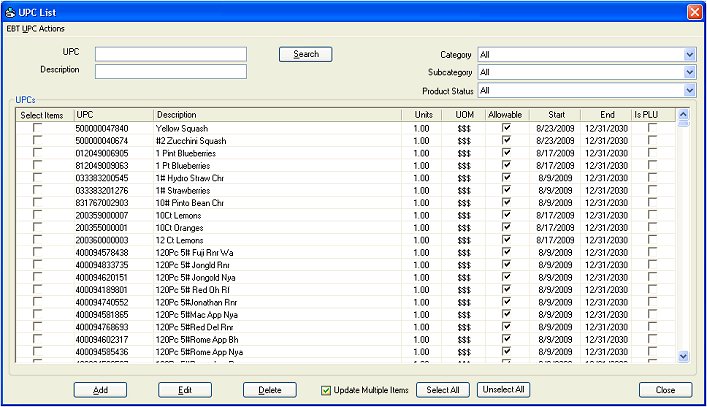
Figure 2 - UPC List screen
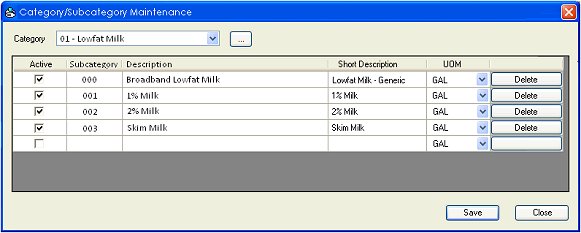
Figure 3 - Category/Subcategory Maintenance screen

Figure 4 - Add Category screen
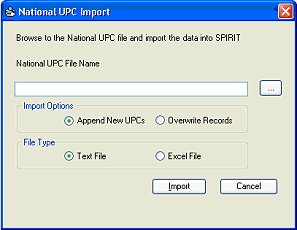
Figure 5 - Import National UPC File screen
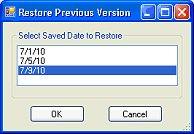
Figure 6 - Restore Previous UPC Version screen
ENH-182
Clinic
Growth Grids
An additional growth grid for Obese Pre-pregnancy BMI was added to the Growth Grids for pregnant women. Participants with a BMI >= 30 will be plotted as obese. Calculated weight, weeks gestation, and plot points on the grid will be created in a similar manner as for other prenatal growth grids. Other screen elements are the same as those on other prenatal growth grids.
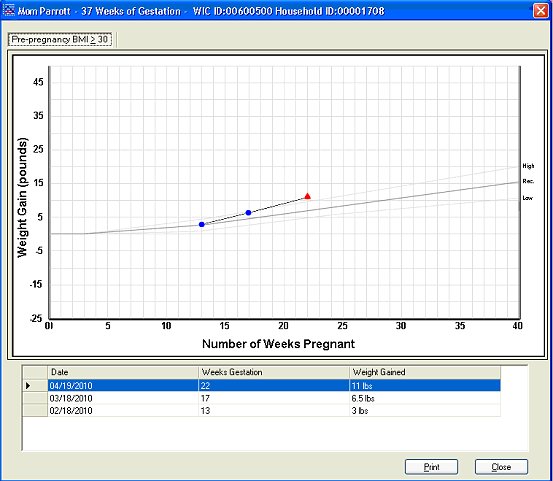
Figure 7 - Obese Pre-pregnancy BMI Growth Grids
Reported Issues
CNEBT-105
Clinic
Add/Replace Set of Benefits
Issue: Users would like to be able to extended a certification by 30 days as per regulations, providing a 7th month of benefits in certain cases. This functionality exists for checks, but is not available in the EBT system.
Resolution: The Add/Replace Set of Benefits screen has been modified for EBT. The new EBT functionality calculates the additional set's FDTU = Expected Cert End Date + 1 day.
This may be different from the certification end date that is displayed for the participant if the State Business Rule allowing certifications to the end of the month is enabled. The Expected Cert End Date can be described as the Last Expected LDTU, or 6 months from the First FDTU of the current certification. Note that this change is per the customer's request and is slightly different from the process used for adding a set of checks. This change affects only EBT; adding a set of checks will not be changed.
Additionally, code was added to calculate a "LastLDTUBeforeEndOfCert" value from the LDTU of the last set of benefits issued after the certification effective date.
In some instances, pseudo certs affected the ability to issue an additional set of checks as they were using the certification effective date instead of the certification start date. The code was changed to use the CertStartDate to fix this issue.
Code was added to compare the newly calculated FDTU of the additional set and the Last Expected FDTU to ensure that both are on or before the certification end date.
The Add Set radio button will be enabled when either of the following conditions are met:
A set of checks has not been issued with a First Date to Use that is past the certification end date of the current certification period of the participant and the current system date is less than or equal to 30 days before the certification end date of the current certification.
OR
The participant is no longer in a valid certification period and the current system date is less than or equal to the next Expected Last Date to Use which occurs after the certification end date.
The two following scenarios help describe these changes:
Scenario 1: If there are no outstanding or future issuances for the household, only a single EBT issuance will be added. The Add/Replace Set of Benefits screen will function in the same manner as it does when adding a set of checks. When the user clicks OK, the Aggregated Issuance for EBT Account screen will be displayed, allowing the user to complete the transaction.
Note that no future household LDTUs will be synced against an issuance that was the result of this process when the Add Set LDTU is after the participant's Certification End Date. This is done to minimize the number of partial packages that are created for a household in an attempt to keep the LDTU synced. As a result, the next issuance after an Add Set for the participant may be a partial package in order to sync with the household. Since this would only occur with a recertification, this was determined to be an acceptable result.
Scenario 2: If there is at least 1 outstanding or future issuance for the household, the additional benefit will need to be split in order to give a full 30 day period and still meet the EBT LDTU syncing requirements. The first issuance cannot be modified. This is the system determined minimum issuance that can occur. The second issuance is optional and will allow the user to adjust the remaining package size and/or the LDTU for the second issuance. When the user clicks OK, the Aggregated Issuance for EBT Account screen will be displayed, allowing the user to complete the transaction.
Note that this scenario does not address situations where there is more than one future benefit outstanding for the household. In those situations, the additional set of benefit's second issuance LDTU may not sync with the other future benefits' LDTU. Since the combination of both issuances could allow for a full 30 days to redeem, and since the next possible FDTU will not be affected for the participant, this was determined to be an acceptable result.
Note: This issue was fully retested for this release.
CNEBT-133
State Office
EBT Household Reconciliation Report (Output)
Issue: Users receive an standard error message when attempting to run the EBT Household Reconciliation Report (Output).
Resolution: The code has been modified to correctly run this report, regardless of the chosen output method.
CNEBT-134
Clinic
Food Adjustment Wizard
Issue: Users are unable to add formula to an infant that was previously issued FBF benefits using the Food Adjustment Wizard.
Resolution: For EBT, future issuances will need to be voided via the Food Adjustment Wizard. Once issuances have been voided and the food prescription updated, users will be able to issue benefits to the participant. The EBT void function has been updated to roll back the LastCheckLDTU to the last issued set for the member record when voiding issuances.
CNEBT-137
Clinic
Food Prescription
Issue: Benefit issuances for evaporated milk are not being displayed on the food issuance reports (Benefit Report (Output) and Account Balance Report (Output)).
Resolution: Some milk items with only one distribution item mapping were being skipped when performing milk aggregation. This required a code fix to double check all milk items to ensure that they are issued. All milk types are now displayed with the correct amounts on the food issuance reports.
CNEBT-145
Clinic
Food Adjustment Wizard
Issue: When a food issuance is prorated, each food item is checked to see if the quantity should be reduced; however, the final prorated category quantities vary. This is causing an under-issuance of soy. Users receive an "Unable to Add Food Item" standard error message.
Resolution: The code has been changed to allow the replacement quantity to equal the original prorated issued quantity. No additional proration checks will occur after the original issuance.
MN-417
Clinic
Food Prescription
Issue: Special prescription start and end dates are not enabled in the Edit Food Item screen for non-formula food items.
Resolution: The code expected only base food categories to have special prescriptions, so all other food item types were being ignored. Code was added to check all food types for a special prescription.
SUG-897
Clinic
Risk Factors
Issue: Risk Factor 135, Inadequate Growth, is being assigned by the system in error when using the Certification Guided Script.
Resolution: This risk factor will be assigned as follows: For infants 14-29 days, the system will assign RF 135 if the weight is less than the birth weight. For infants 1-6 months, the system will find the last measurement at least 30 days before the most recent one and compare the growth based on grams per day. For infants older than 6 months, the system will find the last measurement at least 90 days before the most recent one and compare the growth based on grams per day. For infants 1-6 months and 6 months or older, the birth weight will be used if no other measurement is available.
SUG-896 / SUG-949 / SUG-1004 / SUG-1016 / SUG-1029
Clinic
Issue Benefits
Issue: When adding a set of benefits using the Add/Replace Set of Benefits screen, the FDTU displayed is the End Date of the Certification instead of the day after the previous LDTU.
The last month of benefits will not print for infants.
Users receive the following standard error message when attempting to issue benefits to an infant in a valid certification: "All benefits have been issued for this participant".
When using the Add/Replace Set of Benefits screen to replace a set of benefits for a participant that has been issued benefits to the end of their certification, the system adds a new set of benefits instead of replacing the selected set. Additionally, the new set of benefits begins on the last day of the certification even if a set exists past the certification end date. This creates overlapping sets of benefits.
The End of Certification is extended beyond allowed benefits and will not allow the printing of checks.
Resolution: The code has been modified to calculate the new FDTU of the additional set equal to the Last LDTU before the Certification End Date plus one day. The original logic that determines if a set can be added remains the same.
In an EBT clinic, the Add/Replace Set of Benefits screen has been modified to meet EBTLDTU guidelines. No changes have been made to the screen for non-EBT clinics.
A change was made to the way infants and breastfeeding/non-breastfeeding mothers are evaluated in determining whether a benefit period is valid.
Form logic on the Add/Replace Set of Benefits screen was only checking for control.enabled instead of control.checked. In some situations it would add a set of benefits even though the user selected to replace a set. Code has been added to look for control.checked=True.
SUG-935
Vendor
Vendor Letters
Issue: The Approved Benefits, Benefits Not Approved, and Send Letter screens are displaying the FOODINSTRUMENTID (which is not visible to users) instead of the SERIALNO (the benefit number printed on the check).
When a future date, date prior to the earliest issuance, or date between the earliest issuance and current date is entered on these screens, incorrect standard error messages are displayed.
Resolution: The code was fixed to show and print serial numbers in place of the benefit numbers. Code was fixed for ApprovedChecks, ApprovedChecksAdjustPayAmount, and NotApprovedChecks.
The text of the displayed standard error messages was corrected and the appropriate standard error messages are now displayed.
SUG-946
Clinic
Risk Factors
Issue: Risk Factor 113, Overweight, is being inappropriately assigned by the system when the weight for height is greater than the 85th percentile and less than the 95th percentile. The system is concurrently assigning Risk Factor 114, At Risk of Becoming Overweight, correctly.
Resolution: Only infants less than 12 months old will have RF 114 assigned based on the mother's BMI. Only children 24 months or older will have RF 113 and RF 114 concurrently assigned based on their own health information.
When assigning to a child, RF 114 will always use BMI percent. If the BMI percent is 85% or over but less than 95%, RF 114 will be assigned.
When assigning to a child, RF 113 will use BMI percent unless the child is less than 36 months old and measured recumbent. In that instance, the child's weight for length percentage will be used. In both situations, if the BMI percent or the Weight for Length percentage is 95% or more, RF 113 will be assigned.
A change was made to not assign children RF 114 if RF 113 has been assigned.
SUG-950
Clinic
Risk Factors
Issue: Risk Factor 132, Maternal Weight Loss During Pregnancy, is being assigned when the pre-pregnancy weight equals the weight in the first trimester. This risk factor should only be assigned if the weight in the first trimester is less than the pre-pregnancy weight.
Resolution: The code will now use "less than" instead of "less than or equal to".
SUG-957
Clinic
Food Prescription
Issue: When attempting to issue tofu for a child using the Edit Food Item screen, the Special Prescription Item screen is displayed. Users cannot proceed past this screen if the quantity of tofu is greater than 4 pounds.
Resolution: Repeated prompting for a special prescription was caused by the code expecting only base food categories to have special prescriptions, and ignoring all other food item types. Code was added to check all food types for a special prescription. The code was corrected to ensure that participants are only prompted for a special prescription when tofu is over 4 or 6 pounds, depending on their WIC status.
SUG-963
Clinic
Risk Factors
Issue: Age exceptions should be added to the Date Diff for Risk Factors for the following milestone ages: 4 months, 6 months, 2 years, and 3 years.
Resolution: Code was added to "GetAgeInRoundedMonths()" which prevents rounding up to 4, 6, 12, 24, or 36 months. This ensures that the application only rounds the participant age up when rounding up does not put the participant at one of the Age Category thresholds (with the exception of 1 month). In other words, it does not round the age up for a participant who is near these thresholds.
SUG-970
Clinic
Risk Factors
Issue: Risk factor 133, High Maternal Weight Gain, is being incorrectly assigned to a FBF Woman with Multifetal Gestation.
Resolution: Code was added to check if the MultiFetalGestation flag is set to True before checking for risk factor 133. If it is True, the system will not apply risk factor 133 for a postpartum woman.
SUG-1001
Help
Risk Factor Detail Guide
Issue: The HTML help file is displaying the original Risk Factor Detail Guides, and not those that are customized and maintained by the users.
Resolution: The static Risk Factor Detail Guides are no longer linked in the HTML Online Help System. The Help file will now display the Risk Factor Detail Guide spreadsheets for each of the WIC statuses maintained by users and stored in the {drive letter}:\Users\Public\CSC\WIC\Templates\ folder on the local PC.
Reports
MN-40
Vendor
Reports
Issue: The Check Redemption Analysis by Vendor VND061 (Output) report is currently available in PDF format. It needs to be available in Excel.
Resolution: This report was converted to Excel format.
MN-219
Vendor
Reports
Issue: The Check Redemption Analysis by Peer Group VND062 (Output) and Check Redemption Analysis by Vendor VND061 (Output) reports need to be changed to only include vendors of classes A and B and exclude vendors of classes C, D, and E.
Resolution: The high risk flagging specifications were limited to only include vendors of classes A and B and exclude vendors of classes C, D, and E.
MN-221
Vendor
Reports
A new Fruits and Vegetables Check Redemption Analysis by Vendor VND063 (Output) report was created. This report tracks the number and dollar amount of the fruit/vegetable benefit redemptions by vendor. This report is run as a part of the month-end process.
MN-222
Vendor
Reports
A new Fruits and Vegetables Check Redemption Analysis by Peer Group VND064 (Output) report was created. This report tracks the number and dollar amount of the fruit/vegetable benefits redemptions by class. This report is run as a part of the month-end process.
SUG-850
Vendor
Reports
Issue: Users receive an standard error message when attempting to print a Vendor Profile VND023 (Output) from the Page1 (Demographics) screen.
Resolution: A fix was made to correct the "This field name not known" standard error message.
SUG-895
State Office
Reports
Issue: The Clinic number is being truncated when printing the List of Dual Reported Participation Cases Report ENR002 (Output).
Resolution: This issue occurs when the report is displayed on screen, displayed on screen and then printed, or sent directly to the printer. A fix was made to correct this cosmetic standard error message.